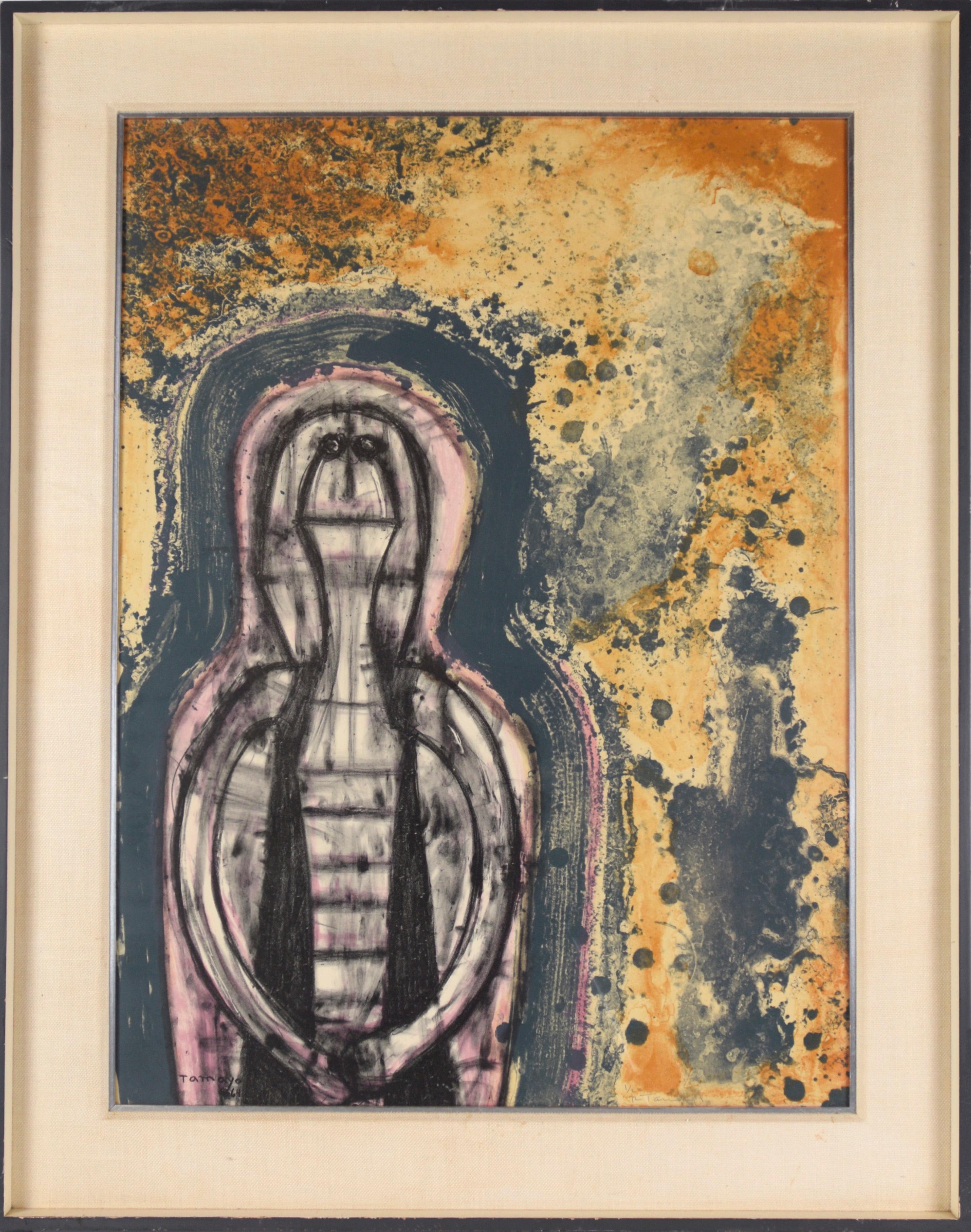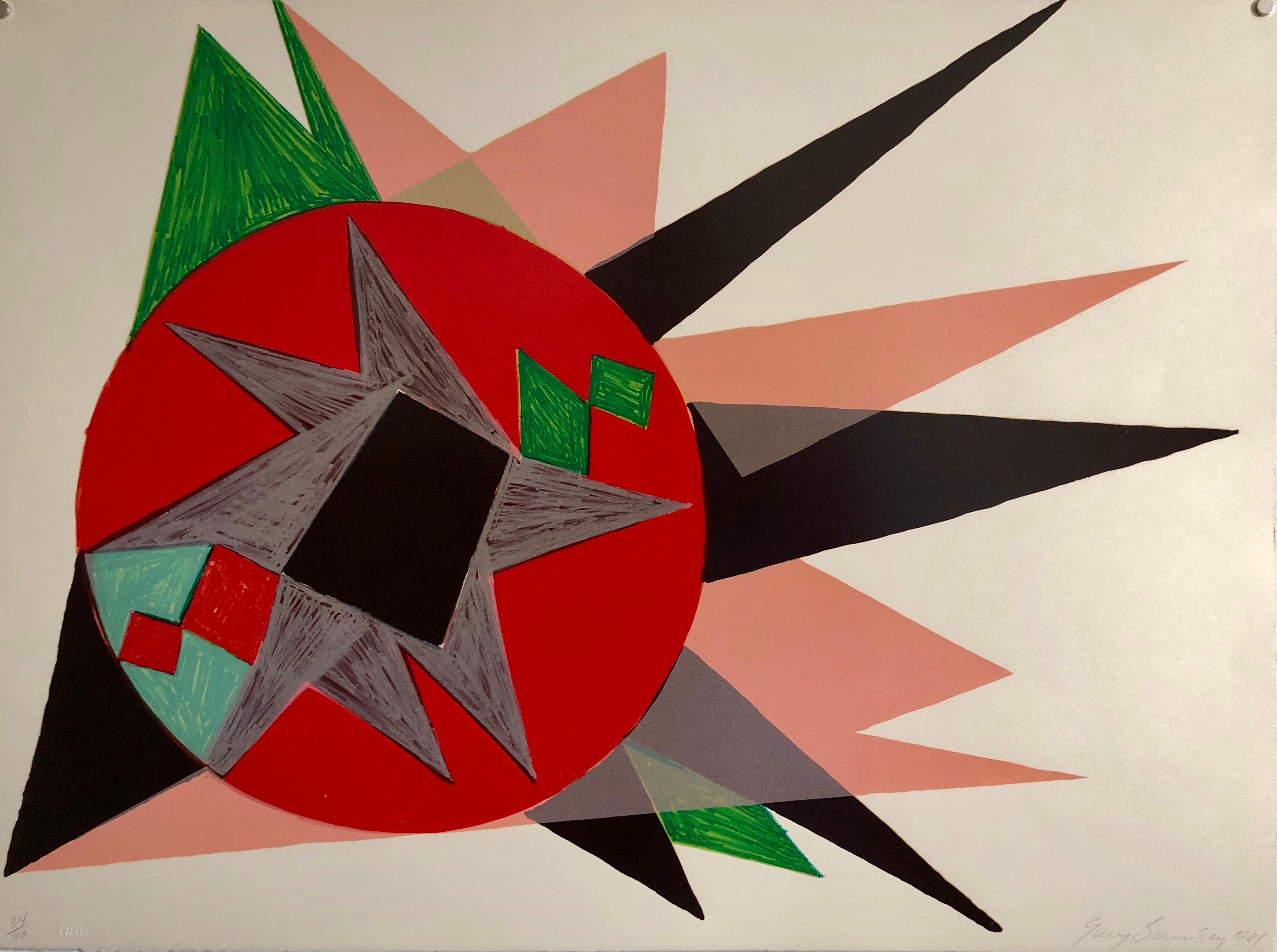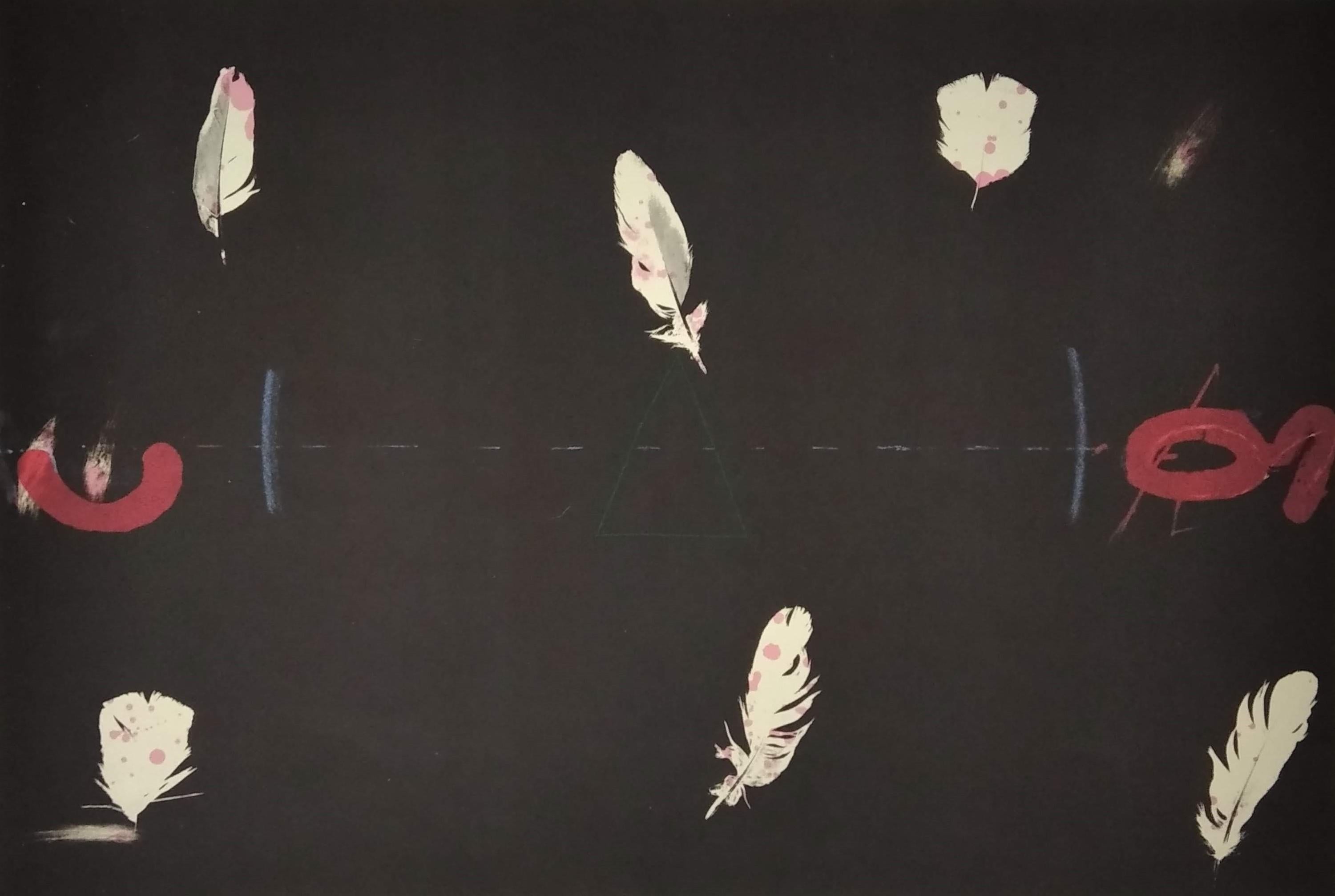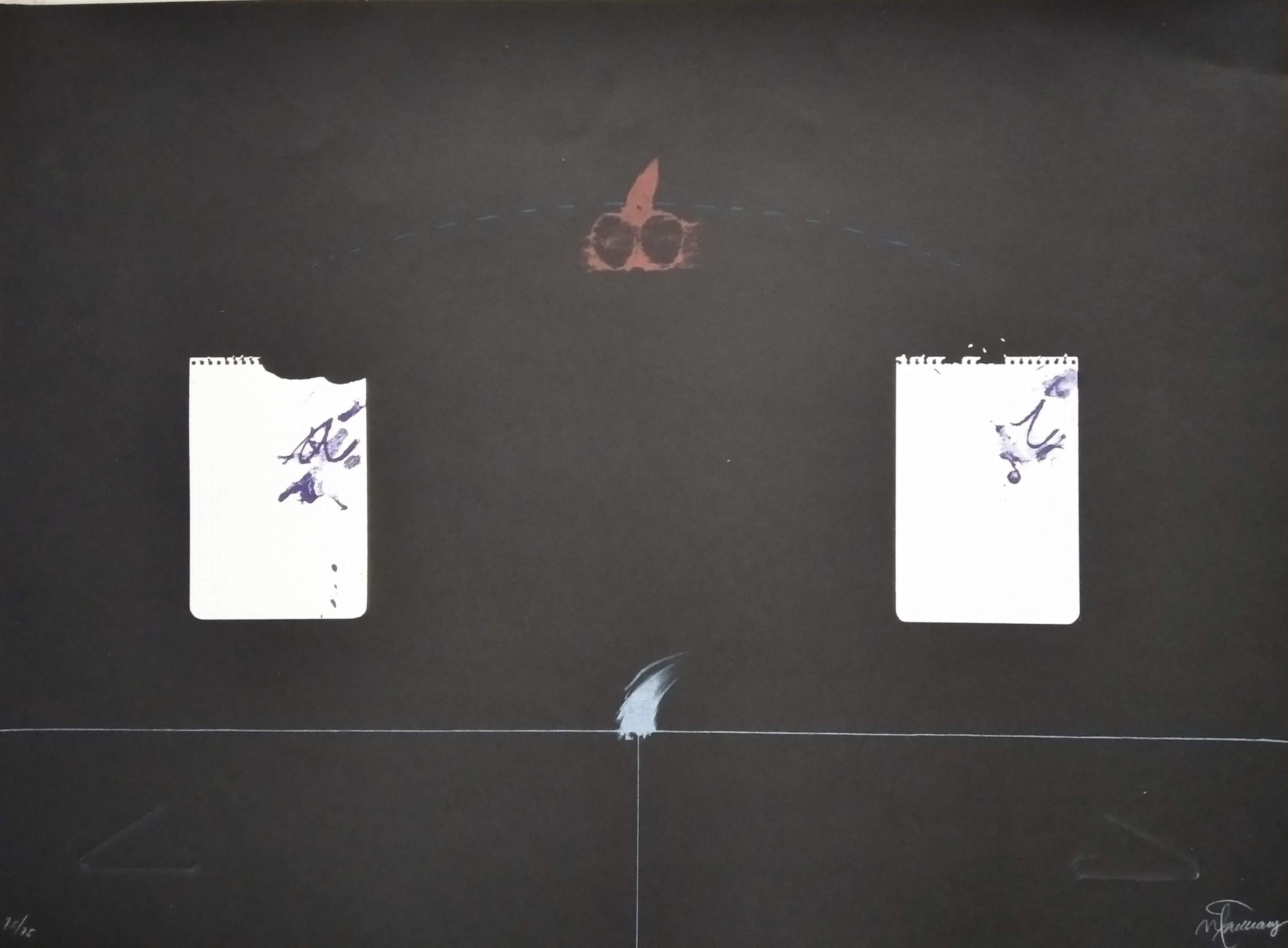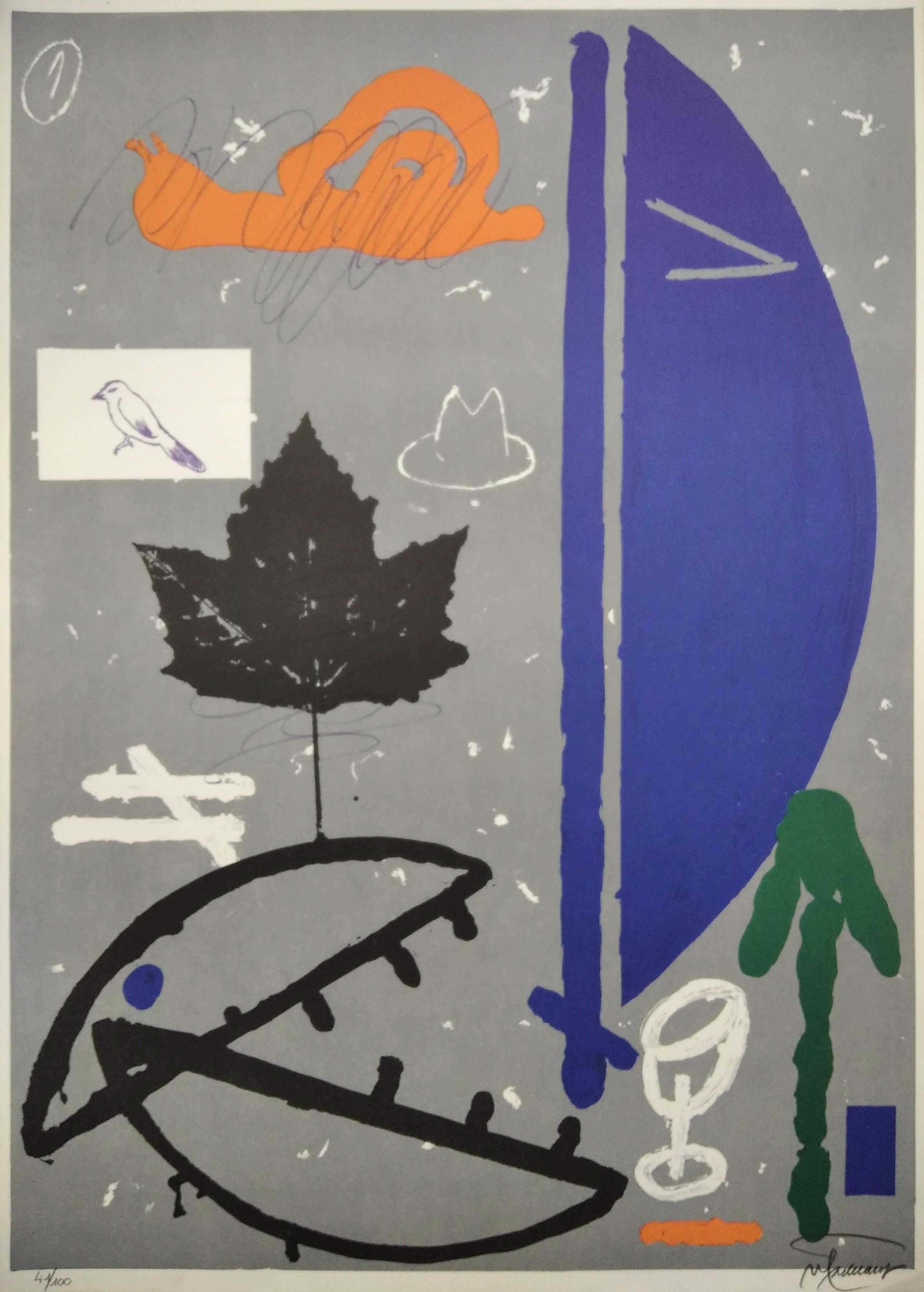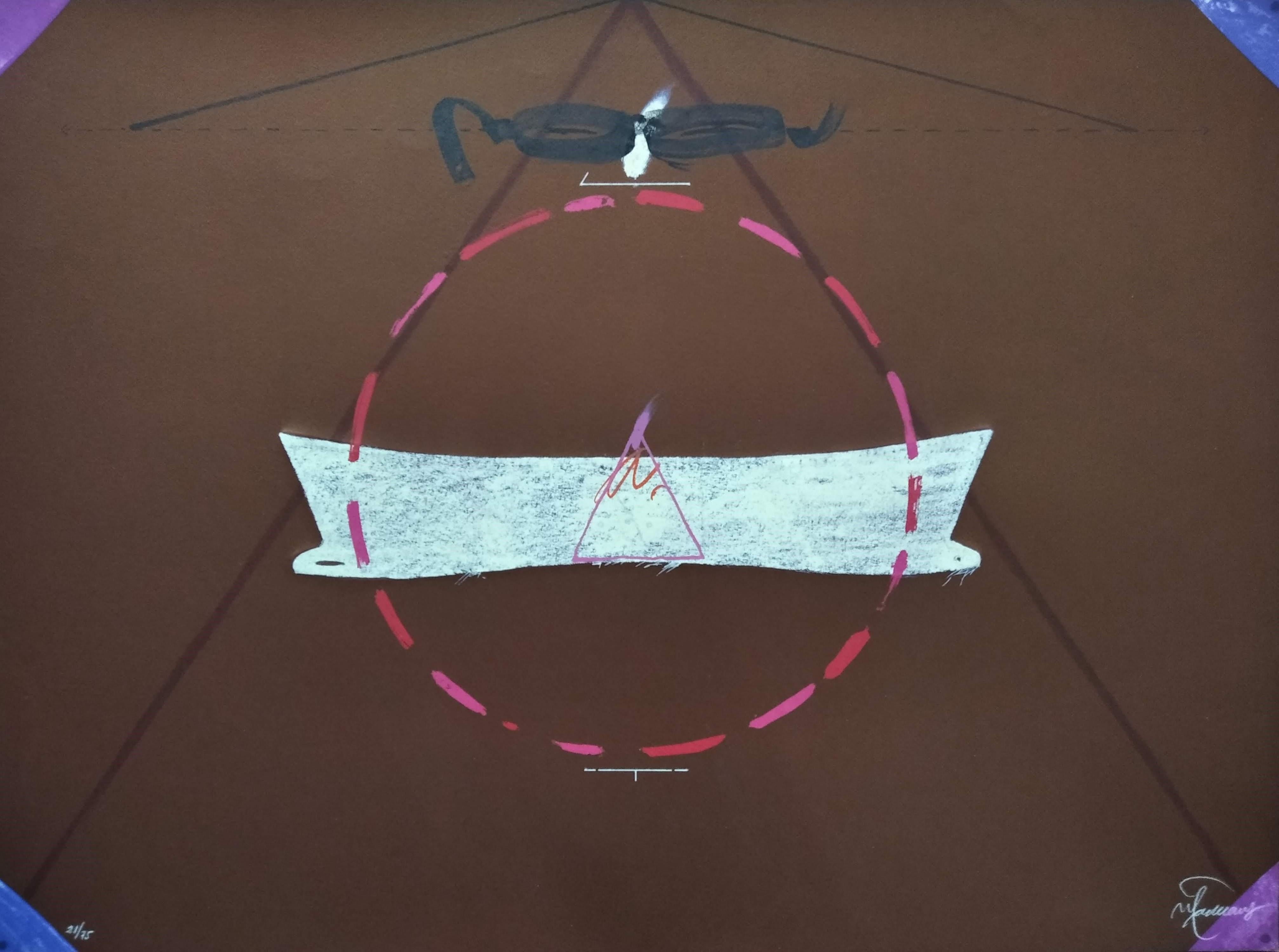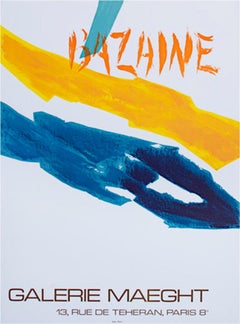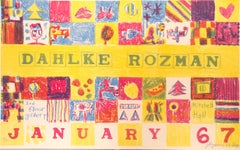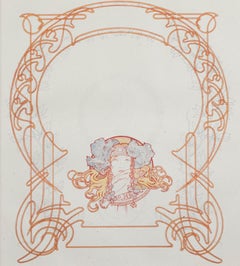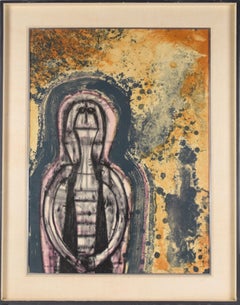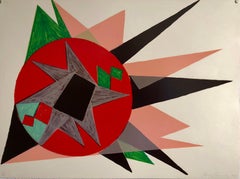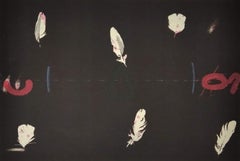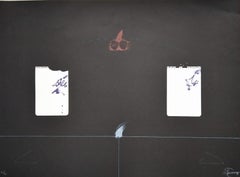Items Similar to "Stabile with Red Sun Galerie Maeght" Lithograph Poster
Want more images or videos?
Request additional images or videos from the seller
1 of 8
"Stabile with Red Sun Galerie Maeght" Lithograph Poster1976
1976
About the Item
"Stabile with Red Sun Galerie Maught" is a color lithograph poster. The Stabile is a black topsy-turvy statue taking up most of the piece. A red sun sits to the right of the black stabile. Unsigned.
Art: 29 x 19 in
Frame: 33 x 22.37 in
American sculptor and painter, born at Lawnton, a suburb of Philadelphia. His grandfather, Alexander Milne Calder, and his father, Alexander Stirling Calder. were sculptors and his mother was a painter. His father had charge of the sculptural work for the Los Angeles World Exhibition in 1912. Alexander Calder, however, studied mechanical engineering from 1915 to 1919 and began to take an interest in landscape painting only in 1922 after having tried his hand at a variety of jobs. In 1923 he enrolled at the School of the Art Students' League. New York, where George LUKS and John SLOAN were among the teachers. Calder and his fellow students made a game of rapidly sketching people in the streets and the underground and Calder was noted for his skill in conveying a sense of movement by a single unbroken line. He also took an interest in sport and circus events and contributed drawings to the satirical National Police Gazette. From these activities it was but a step to his wire sculptures, the first of which -- a sun-dial in the form of a cock -- was done in 1925. In 1927 he made moving toys for the Gould Manufacturing Company and small figures of animals and clowns with which he gave circus performances in his studio. His first exhibition of paintings was in the Artists' Gal.. New York, in 1926; his first Paris one-man show was in the Gal. Billiet in 1929 and the Foreword to the catalogue was written by PASCIN. whom he had met the previous year. His wire figures were exhibited by Carl Zigrosser at the Weyhe Gal. and Bookshop, New York, in 1928 and at the Neumann and Nierendorf Gal., Berlin, in 1929, when they were made the subject of a short film by Dr. Hans Curlis. During the 1930s Calder became known both in Paris and in America for his wire sculpture and portraits, his abstract constructions and his drawings. In 1931 he joined the ABSTRACTION-CREATION association and in the same year produced his first non-figurative moving construction. The construetions which were moved by hand or by motor power were baptized 'mobiles' in 1932 by Marcel DUCHAMP and ARP suggested 'stabiles' for the non-moving constructions in the same year. It was in 1934 that Calder began to make the unpowered mobiles for which he is most widely known. Constructed usually from pieces of shaped and painted tin suspended on thin wires or cords, these responded by their own weight to the faintest air currents and were designed to take advantage of effects of changing light created by the movements. Thev were described by Calder as 'four-dimensional drawings'. and in a letter to Duchamp written in 1932 he spoke of his desire to make 'moving Itlondrians'. Calder was in fact greatly impressed by a visit to Mondrian in 1930 and no doubt envisaged himself as bringing movement to Mondrian-type geometrical abstracts. Yet the personality and outlook of the two men were very different. Calder`s pawky delight in the comic and fantastic, which obtrudes even in his large works, was at the opposite pole from the Messianic seriousness of Mondrian. Calder continued to do both mobiles and stabiles until the 1970s, sometimes combining the two into one structure. Some of these works were of very large dimensions: Teodelapio (1962), a stabile for the city of Spoleto, was 18 m high and 14 m long; Man, done for the Montreal World Exhibition of 1967, was 23 m high; Red Sun (1967) for the Olympic Stadium, Mexico, was 24 m high and the motorized hanging mobile Red. Black and Blue (1967) at Dallas airport was 14 m wide. His interest in animal figures and the circus also continued into the 1970s and in 1971 he was making 'Animobiles' reminiscent of animals. Although he had done gouaches since the late 1920s, he began to take a more serious interest in them and to exhibit them from 1952.
- Creation Year:1976
- Dimensions:Height: 33 in (83.82 cm)Width: 22.37 in (56.82 cm)
- Medium:
- Movement & Style:
- After:Alexander Calder (1898 - 1976, American)
- Period:
- Condition:
- Gallery Location:Milwaukee, WI
- Reference Number:Seller: 511d1stDibs: LU60535524752
About the Seller
4.9
Gold Seller
Premium sellers maintaining a 4.3+ rating and 24-hour response times
Established in 1966
1stDibs seller since 2017
429 sales on 1stDibs
Typical response time: 2 hours
- ShippingRetrieving quote...Shipping from: Milwaukee, WI
- Return Policy
Authenticity Guarantee
In the unlikely event there’s an issue with an item’s authenticity, contact us within 1 year for a full refund. DetailsMoney-Back Guarantee
If your item is not as described, is damaged in transit, or does not arrive, contact us within 7 days for a full refund. Details24-Hour Cancellation
You have a 24-hour grace period in which to reconsider your purchase, with no questions asked.Vetted Professional Sellers
Our world-class sellers must adhere to strict standards for service and quality, maintaining the integrity of our listings.Price-Match Guarantee
If you find that a seller listed the same item for a lower price elsewhere, we’ll match it.Trusted Global Delivery
Our best-in-class carrier network provides specialized shipping options worldwide, including custom delivery.More From This Seller
View All"Galerie Maeght, " Graphic Color Lines Lithograph Poster by Jean Rene Bazaine
Located in Milwaukee, WI
"Galerie Maeght" lithograph poster by Jean Rene Bazaine. This poster holds Bazine's name in harsh orange lines near the top of the piece. Diagonally bisecting the b and a in Bazaine is a teal line. Bellow this horizontally against the white backgrounds are two lines, one painted yellow and the other blue.
Image: 29 x 21 in
Jean Bazaine was a French painter, designer of stained glass windows, and writer. He was the great great grandson of the English Court portraitist Sir George Hayter. In 1949/1950 he had his first major one man show at the Galerie Maeght, who remained his art dealer thenceforth. From then on it was a steady progress of major exhibitions: Bern, Hanover, Zürich, Oslo... 1987 a retrospective exhibition in Galerie Maeght, 1988 a retrospective of his drawings in the Musée Matisse and finally in 1990 the Exposition Bazaine in the Galeries Nationales du Grand Palais, Paris., which was accompanied by the reissue of his major texts on painting in art theory as Le temps de la peinture (Paris, Aubier 1990). "The motley crowds of international tourists and souvenir-shoppers who fill the ancient streets of the Latin Quarter in Paris spend most of their time admiring the open-air displays of seafood outside the Greek restaurants in the rue de la Huchette. They ignore the beautiful church of St Severin in the same street, for have they not already "done" Notre Dame? So they miss one of the most wonderful series of stained-glass windows in France: Jean Bazaine's vivid, dynamic works irradiating the sombre ambulatory and apsidal chapels. These windows represent the seven sacraments of the Church, portrayed as essential forms from nature in all its glory and symbolising Water, Fire and Light, sacred emblems of Divine Grace. An appropriate biblical verse is inscribed beneath each. Only Pierre Soulages with his "luminous black" windows at l'Abbaye de Conques (1998) can stand comparison with the majesty of these contemporary works by Bazaine, created between 1965 and 1970. Bazaine was fortunate in his friends. He received at an early stage in his student career support and advice from another master colourist, Pierre Bonnard. In his youth he knew Leger, Braque, James Joyce and Marcel Proust. One of his great personal friends was Jean Fautrier, with whom he shared his first exhibition in 1930. His work gradually developed as a form of bold tachisme - brilliantly composed but well-controlled "splashes" of sumptuous colour. He rejected the term "abstract" which he considered a denial of the essentially intimate relationships between art and reality. He quoted his friend Braque: "The canvas must efface the idea behind it." In 1941, during the Nazi occupation, at a time when Hitler was destroying many works of modern art, Bazaine had the courage to organise in Paris a first "avant-garde" exhibition of 20 French artists. In 1948, he wrote his first book, an unpedantic, unacademic view of contemporary painting, Notes sur la peinture d'aujourd'hui. He quotes Braque on Cezanne: "He's a painters' painter - other people think it's unfinished." Bazaine, too, reverenced Cezanne: Three lines drawn by Cezanne overturn our whole concept of the world, proclaim the liberty of man, his courage. The great painters have never had any other aims. The painter says: "I exist, therefore you exist. I am free, therefore you are free. Or at least he tries to. It's his one aim in life." After the Second World War, Bazaine produced vast compositions with virtuoso colour structures, mostly with references to nature, like the breathtaking Vent de mer (1949, now in the Museum of Modern Art, Paris) and Orage au jardin (1952, now in the Van Abbemuseum at Eindhoven). His Earth and Sky (1950) is in the Maeght Foundation at Saint Paul de Vence. One of his greatest works, L'Arbre tenebreux (1962), was sold to the Sonja Henie...
Category
1970s Post-Modern Abstract Prints
Materials
Lithograph
"Don't Wine, " Original Surreal Serigraph by Paula Schuette Kraemer & Bill Weege
By Paula Schuette Kraemer
Located in Milwaukee, WI
"Don't Wine" is a mixed media piece, predominately a serigraph, by Paula Schuette Kramer and Bill Weege. Both artists signed in pencil in the lower right, and the title is in the lower left. It is one of a an edition of 50. The print is an explosion of bright colors, but red, blue, and green dominated the composition as they fade through the background. A blue figure climbs up a ladder out of an apple, hefting a large wine bottle overhead, which they pour out into the sea of wine. A man, woman, and long-necked orange bird also look out from the apple, reading for the stem of a floating bunch of green grapes. A group surrounds the grapes with their heads and shoulders above the water, eating the fruit. Birds fly through the background, dodging wine glasses and a vase of flowers that seem to be tumbling from a flying carpet. The entire image feels very surreal.
Art size: 12" x 10"
Frame size: 19 1/4" x 17"
Paula Schuette Kraemer is an independent artist living in Madison, Wisconsin...
Category
1990s Post-Modern Abstract Prints
Materials
Mixed Media
"Dahlke-Rozman, Exhibition Poster, " Original Color Lithograph by Joseph Rozman
By Joseph Rozman
Located in Milwaukee, WI
"Dahlke-Rozman, Exhibition Poster" is an original color lithograph by Joseph Rozman. Rozman signed the work on the lower right side. This artwork advertises an exhibition of works by...
Category
1960s Pop Art Abstract Prints
Materials
Lithograph
Late 19th century color lithograph art nouveau ornate bookplate
By Alphonse Mucha
Located in Milwaukee, WI
"Title Page" and "Art Nouveau Motif" are two sides of one double-sided original lithograph by Art Nouveau master Alphonse Mucha. These illustrations were from "Ilsee, Princess of Tri...
Category
1890s Art Nouveau Portrait Prints
Materials
Lithograph
"Elizabeth Stein Gallery A/P, " Lithograph Exhibition Poster by Ilya Bolotowsky
By Ilya Bolotowsky
Located in Milwaukee, WI
"Elizabeth Stein Gallery A/P" is a color lithograph poster by Ilya Bolotowsky. This piece features an abstract and geometric design in yellow.
40" x 26"
Born in Russia in 1907, Ilya Bolotowsky left his native country in his early childhood. The family was forced to emigrate as a result of his parent’s anti-Communist sentiments. They traveled first to Constantinople, then settled in New York City in 1923. Bolotowsky enrolled at the National Academy of Design in 1924. He tried out many styles in this period, ranging from the representational and classical to the abstract and expressionistic. In the early 1930s he became a designer of textiles. In 1932 Bolotowsky spent ten months in Europe. Although he was already familiar with prevailing modernist movements, the opportunity to study a wide range of these works and to meet some of the artists who had made them affected Bolotowsky profoundly. As a result of this trip, Bolotowsky began to synthesize aspects of Cubism with the abstract Surrealism of artists like Miro and Arp. These softer, floating forms gave way to a rectilinear geometry as he became more influenced by the Constructivists and Mondrian. Upon his return to the United States, Bolotowsky married his fellow painter Esphyr Slobodkina...
Category
1970s Abstract Geometric Abstract Prints
Materials
Lithograph
Pour Daniel-Henry Kahnweiler Figure in Landscape
By Yves Rouvre
Located in Milwaukee, WI
"Pour Daniel-Henry Kahnweiler Figure in Landscape" is an original lithograph by Yves Rouvre. The artist signed the piece lower right. It features an abstracted figure in fields of co...
Category
1960s Modern Figurative Prints
Materials
Lithograph
You May Also Like
"Personaje en un Cueva" (Personage in a Cave) Surrealist Lithograph
By Rufino Tamayo
Located in Soquel, CA
"Personaje en un Cueva" (Personage in a Cave) Surrealist Lithograph by Rufino Tamayo (b. 1899 d. 1991.)
Abstract figurative lithograph featuring a textured background and bold figur...
Category
1960s Post-Modern Figurative Prints
Materials
Paper, Lithograph
Lithograph w Gloss Overprinting Stacked Signs Post Modern 80s Memphis Milano Era
Located in Surfside, FL
Untitled, 1981 (Stacked Signs Series) lithograph with Glosscote overprinting. Published by Holly Solomon Editions. (original gallery label photo is included for reference and not included in sale)
Hand signed and numbered from limited edition of 40.
This is a beautiful piece perfect for the Memphis Milano early 1980's Post Modern Era. It also bears influence from Pop Art (Particularly Allan D'Arcangelo)
Gary Burnley...
Category
1980s Post-Modern Abstract Prints
Materials
Lithograph
Untitled
Located in Barcelona, BARCELONA
Includes a Certificate of Authenticity
Category
Early 2000s Post-Modern Abstract Prints
Materials
Lithograph
Entrebanc 14
Located in Barcelona, BARCELONA
Includes a Certificate of Authenticity
Category
1970s Post-Modern Abstract Prints
Materials
Lithograph
Untitled
Located in Barcelona, BARCELONA
Includes a Certificate of Authenticity
Category
Early 2000s Post-Modern Abstract Prints
Materials
Lithograph
Entrebanc 7
Located in Barcelona, BARCELONA
Includes a Certificate of Authenticity
Category
1970s Post-Modern Abstract Prints
Materials
Lithograph
Recently Viewed
View AllMore Ways To Browse
Vintage Construction Posters
Vintage Engineering Posters
Hanging Mobile
Stabile Sculpture
M And M Statue
Tin Man
Vintage Game Posters
Sun Dial
Mexico Tin
Cock Sculpture
Vintage Animal Toys
Vintage Toys 1930s
Small Cock
Vintage Construction Toys
Vintage Mexican Tin
Studio Stirling
Vintage Hanging Mobile
Dial M For Modern
